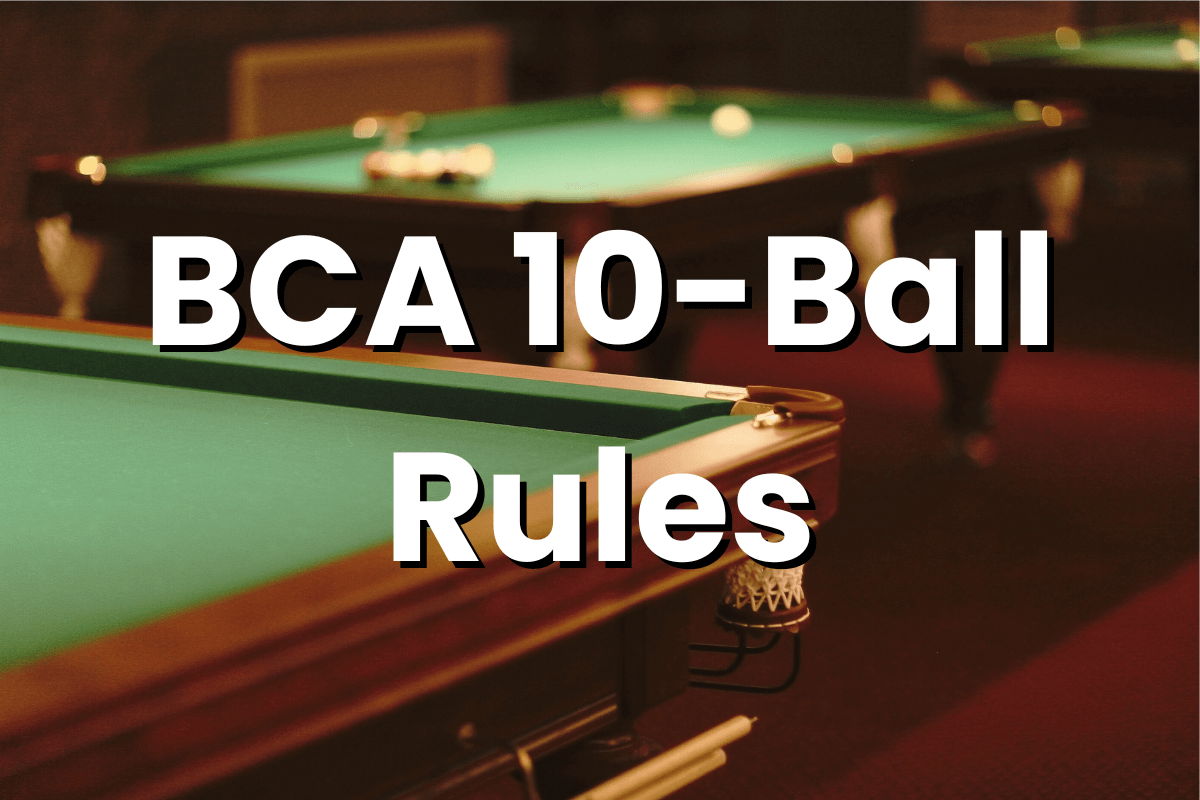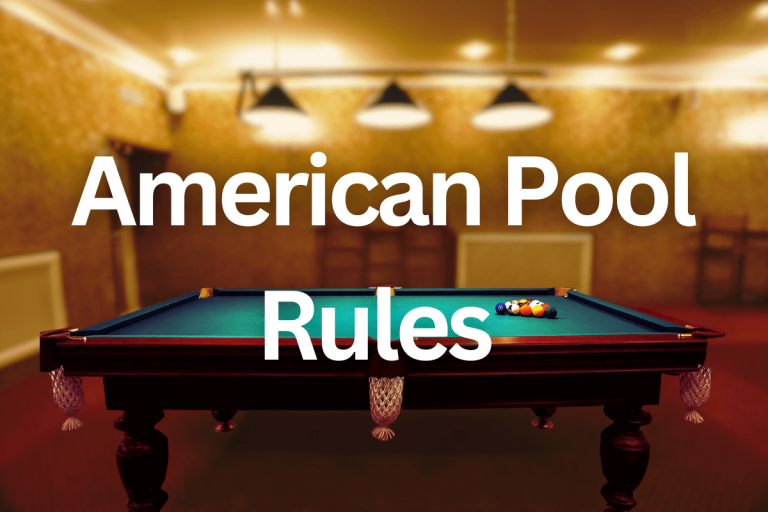BCA 10-Ball Rules with Tips from the Pros (2024)
Explore the realm of precision and strategy with BCA 10-Ball Rules, a testament to the Billiards Congress of America’s (BCA) commitment to excellence in cue sports. This variant is swiftly rising in popularity, captivating players with its demanding yet rewarding gameplay. Embracing the BCA 10-Ball Rules hones your skills and connects you to a growing community that cherishes this esteemed billiard discipline’s complexity and competitive spirit.
Fundamentals of BCA 10-Ball Rules
The object of the Game
The primary goal in BCA 10-Ball is to legally pocket the 10-ball after making legal contact with the lowest-numbered ball on the table. The game combines elements of strategy, skill, and precision, with players needing to execute offensive and defensive shots to outmaneuver their opponents.
Winning Conditions: A player wins the game by pocketing the 10-ball on a legal shot after all preceding balls have been pocketed or in a called pocket on a combination shot, provided no fouls are committed.
Player Requirements
Eligibility: Players of all skill levels can participate in BCA 10-Ball games, although official tournaments may have specific eligibility criteria, such as membership in the BCA or adherence to ranking qualifications.
Conduct: Players are expected to maintain a high standard of sportsmanship and fair play. This includes respecting opponents, refraining from distracting behavior, and adhering to the rules and decisions of referees or officials during competitive play.
10-Ball Rack Rules
- The balls are racked in a triangle at the foot of the table with the 1-ball positioned at the apex on the foot spot. The 10-ball is placed in the center of the rack, and the other balls are arranged randomly, but tightly, ensuring every ball is in contact with its neighbors.
- The rack is positioned so that the 1-ball is at the front, directly on the foot spot, ensuring a fair setup for the break shot.
BCA 10-Ball Rules in Detail
The Break
- The game begins with a player performing the break shot. The player must strike the 1-ball first and either pocket at least one ball or drive at least four numbered balls to the rail to execute a legal break.
- If the breaker fails to meet these conditions, it’s considered an illegal break, leading to a re-rack, or the incoming player may choose to play the table as is, with the cue ball in hand behind the headstring.
- The 10-ball pocketed on a break doesn’t win the game. Instead, it is spotted, and the player continues their turn.
Call Shot
- In BCA 10-Ball, precision is key. Players must call both the ball they intend to pocket and the pocket into which it will be pocketed. The shot doesn’t need to be described in detail, as long as the ball and pocket are specified.
- If a player pockets the called ball in the called pocket under legal conditions, they continue their turn. However, if the player pockets an unintended ball or misses the called pocket, the incoming player can accept the table as is or pass the turn back.
Continuing Play
- Players must hit the lowest-numbered ball on the table first. A legal shot requires the cue ball or any other ball to touch a rail after the cue ball contacts the lowest-numbered ball. Failure to meet these conditions is a foul.
- The game proceeds with players taking turns, trying to pocket balls in ascending numerical order.
Foul Penalties
- Committing a foul like pocketing the cue ball or jumping out the ball, results in the end of the player’s turn, and the incoming player is awarded the ball in hand.
- Common fouls include failing to hit the lowest-numbered ball first, not driving any ball to a rail after the cue ball contacts the object ball, pocketing the cue ball (scratch), and playing out of turn.
- A serious foul or unsportsmanlike conduct can lead to disqualification.
Winning the Game
- The game is won when a player legally pockets the 10-ball after all the preceding balls have been pocketed, or if the 10-ball is pocketed on a legally called combination shot.
- A player loses the game if they pocket the 10-ball illegally, commit three consecutive fouls, or are found to have engaged in unsportsmanlike conduct.
Advanced Play: Tips from the Pros
Professional players bring a wealth of experience and strategic depth to BCA 10-Ball, and their insights can elevate your game to the next level. Here are some advanced tips and strategies shared by seasoned pros:
Plan Multiple Shots
Pros think three to five shots ahead, planning their routes on the table. This foresight allows them to position the cue ball strategically for subsequent shots, ensuring a smooth run-out.
Master the Break
The break is crucial in 10-Ball. Pros recommend practicing your break to consistently pocket a ball and control the cue ball, ideally positioning it near the center of the table to maximize your options for the next shot.
Precision in Position Play
Control over the cue ball is paramount. Pros spend a significant amount of time practicing cue ball control, focusing on speed and spin to land in the ideal position for the next shot.
Defensive Strategies
Sometimes, the best offense is a good defense. Pros are adept at playing safe when the layout is unfavorable. They recommend mastering shots that leave the cue ball in a position that’s difficult for the opponent, forcing them to make a mistake.
Emotional and Mental Discipline
The psychological aspect of the game is as important as the physical one. Pros emphasize the importance of staying calm, focused, and mentally resilient, even when the game isn’t going in your favor.
Practice with Purpose
Pros don’t just hit balls around the table. They practice intentionally, focusing on weak areas of their game, and often simulate match conditions to prepare for tournaments.
Study Your Opponents
Understanding your opponent’s strengths and weaknesses can give you a strategic edge. Pros watch matches, learn from others’ playing styles, and adapt their strategy accordingly.
Continuous Learning
The learning never stops. Even professionals continually seek to learn new techniques, strategies, and perspectives. They stay updated with the latest trends and innovations in the sport.
Official Resources and Further Learning
To fully grasp the intricacies of BCA 10-Ball and continuously improve your skills, it’s essential to access reliable resources. Here’s a guide to some of the most authoritative sources and educational materials:
Official BCA Resources
Billiards Congress of America (BCA) Official Website: The BCA’s official website (www.playbca.com) is the primary resource for official rules, regulations, and updates in the world of billiards. It’s the go-to place for authentic information.
BCA Rule Book: The BCA publishes an official rule book which is periodically updated to reflect changes in the game. This rule book is a comprehensive guide covering not just the rules but also equipment specifications, player conduct, and competition guidelines.
Recommended Books
The 99 Critical Shots in Pool: Everything You Need to Know to Learn and Master the Game by Ray Martin and Rosser Reeves: This book is a classic, offering insights into various shots and strategies.
Pleasures of Small Motions: Mastering the Mental Game of Pocket Billiards by Bob Fancher, Ph.D.: Focuses on the psychological aspects of playing pool, offering advice on how to stay focused and improve your mental game.
Conclusion
Understanding BCA 10-Ball Rules is pivotal for anyone aiming to excel in this strategic and skillful game. By embracing these guidelines, players not only enrich their experience but also uphold the sport’s integrity. Engaging with the pool community and participating in events further enhances one’s prowess, weaving a tapestry of camaraderie and competition. Immerse yourself in the world of BCA 10-Ball, where every shot is a step toward mastery and every game a celebration of precision and passion.
FAQs
What is the main objective of BCA 10-Ball?
The main objective of BCA 10-Ball is to legally pocket the 10-ball after legally pocketing the nine preceding balls in any order. This requires strategic shot selection and execution, aiming to strategically position the balls for your next shot and ultimately sink the 10-ball to win the game.
Can I win the game on the break in BCA 10-Ball?
No, pocketing the 10-ball on the break doesn’t result in a win. If the 10-ball is pocketed on the break, it is respotted and the player continues their turn.
Do I need to call every shot in BCA 10-Ball?
You are required to call the pocket for the 10-ball and any shot that isn’t obvious. This includes calling bank shots, combinations, or caroms. However, you don’t need to specify details like kisses, caroms, or the number of cushions involved for other balls.
What constitutes a foul in BCA 10-Ball?
Common fouls include failing to hit the lowest-numbered ball first, not driving any ball to a rail after the cue ball contacts the object ball, pocketing the cue ball (scratch), and playing out of turn.
How are the balls arranged for the break in BCA 10-Ball?
The balls are racked in a triangle at the foot of the table with the 1-ball at the apex on the foot spot, the 10-ball in the center of the triangle, and the other balls placed randomly.
Can I lose the game instantly in certain situations?
Yes, you can lose the game instantly if you pocket the 10-ball unlawfully, commit three consecutive fouls, or are found to have engaged in unsportsmanlike conduct.







